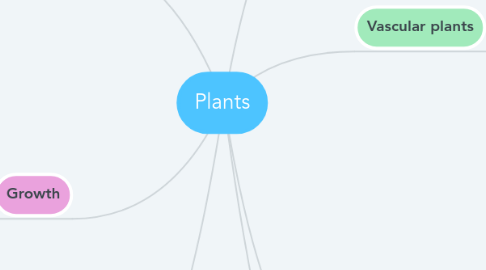
1. Roots
1.1. Functions are to hold the plant in the soil, absorb water and minerals in some cases also stores and controls soil erosion.
1.1.1. Water and mineral transport, water enters the root through osmosis using the vascular tissue, and all minerals enter using the active transport.
1.2. 2 main types of roots
1.2.1. Fibrous ( monocot), profusely branch roots, occupy a large volume of shallow around a plant's base examples are petunias, beans and peas.
1.2.2. Taproot (dicot), has one main downward rowing root, with limited branching and where soil permits.
2. Growth
2.1. Plants grow in 2 different ways
2.1.1. primary growth, grows in length of roots and stems throughout life, there is growth in diameters of roots and stems in the 1st year this applies to all plants
2.1.2. Secondary growth, results from cell division in the cambia or lateral meristems and that causes the stems and roots to thicken
3. Leaves
3.1. primary site of photosynthesis, able to capture sunlight, carry out gas exchange and prevent dehydration. leaves come in various sizes and shapes. can be simple or compound, simple leafs are leaves without leaflet and compound have 2 or more leaflets.
3.2. Petiole, stalk or support that attaches to the blade of a leaf to the stem and has vascular tissue connections.
3.3. Guard cells during the day, sunlight and low CO2 which then signal potassium ions and they move into the guard cells. forces water to enter through osmosis then guard cells expend and move away from each other.
3.3.1. osmosis the movement or diffusion of water from an area of high concentration to low concentration
3.4. Guard cells during the night potassium ions move out of guard cells and water follows, the guard cells then shrink and the stoma closes
4. Definition
4.1. Multicellular autotrophs, photosynthetic, believed to have evolved from green algae.
5. Vascular plants
5.1. These plants are more advanced, have evolved from non - vascular plants and have xylem/phleom (vascular tissue). have true roots stem and leaves
5.1.1. Root system, roots are what hold the plants into the soil, absorbs water and minerals, with then transfer the water and minerals to the stem and in some plants roots are a place for storing food.
5.1.2. Stem system, this includes leave and stems. Leaf is the place where photosynthesis occurs and stem supports the leaves, transports water and minerals to the leaves, sugars forms the leaves and some also store food.
5.2. Gymnosperms are seed producing and have seeds without seed coats
5.3. Angiosperms, produce seeds have seeds with seed coats, flower plants and steam bundles are scattered
5.3.1. 2 subclasses
5.3.1.1. Monocoats (grains and grass)
5.3.1.2. Dicots are common plants like trees and tomatoes
6. Plant tissues
6.1. Specialized for absorption, transports storage, photosynthesis and reproduction. 3 main tissue types: 1.) Dermal tissue 2.) Ground tissue 3.) Vascular tissue
6.1.1. 1.) Dermal tissue has an epidermis which is the dermal tissue for non-woody plants, supports and protects the plant, called the skin of the plant and has a stone which allows for gas and water exchange
6.1.2. 2.) Vascular tissue conduct materials such as water and nutrients throughout the plant and for structural support. Includes xylem which transports dissolved minerals upwards from roots to shoots and phloem transport food in photosynthesis to parts of plant that do not photosynthesize life developing leaves, flowers and fruits. Location is at the centre of roots
6.1.3. 3.) Ground tissue fills the spaces between dermal and vascular tissue, to synthesis organic compounds and to support the plant and provide storage for the plant.
